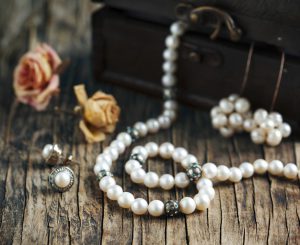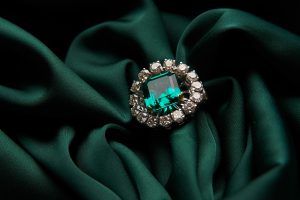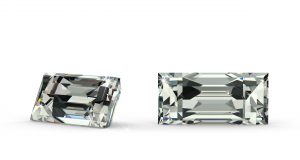When I left Vogue after twenty five years as Editor-in-Chief, I was allowed to choose a print from the incredible archives. Since the magazine was founded in 1916, there was over a hundred years of beautiful era-defining photographs and illustrations of the fashions and styles of the day to pick from. Unimaginably elegant women in taffeta and duchesse silk ballgowns, Swinging Sixties black and white shots of Twiggy and Jean Shrimpton in mini dresses, the mannered poses of aristocratic looking models in Dior’s New Age silhouette, were all among the options. How was one to choose?

After many hours of searching I decided on an illustration published in the 1943 Christmas edition by Carl Erickson, one of the famous Vogue illustrators. In pastels and ink it portrays a woman, from the side, her hair swept up to better show off the large double strand of pearls around her neck fastened by a clasp. We can’t see her face but her nails are carmine tipped and she is obviously clipping an earring onto her ear. An enormous cabochon cut diamond is on her wedding finger. The caption read “Give her pearls….not just an anonymous little strand that she might fasten on automatically…..but great big ones like these”. Indeed. The pearls, the diamonds, the suggestion of an earring, together with the delicate and sensuous lines of the image encapsulated so much of not only the subject matter that I worked with at Vogue, but also of something both luxurious and intangible. Certainly this beautiful woman (I assume her beauty even though I can’t see the features of her face) leads a glamorous existence that is demonstrated, along with her sleek up-do and the fashionable neckline of her deep purple dress, by her collection of classic aspirational jewellery. And that might be enough. But as I look at the pearls, the lines of the diamond ring, and imagine the invisible earrings as glittering diamond studs, I am seeing something else. I see privilege, good taste, position in society. She adorns herself in preparation for the evening ahead, the jewellery a statement of who she wants us to think she is. And that’s the thing. Nothing has quite the sweep of purpose as jewellery.
It’s one of the great multi-taskers – a trophy, a token of love, an indicator of status. It adorns and decorates us and has done since the earliest human times. And it is of both great emotional and financial worth. Jewellery is a currency valued by all. What defines something as precious? Why do we all, across so many cultures, centuries and civilisations share this understanding of the worth of jewellery? What gives it such value? Generally societies value most, that which is hard to achieve. Things that are accessible to all are likely to be valued less. Gemstones, gold and silver have to be discovered, extracted, polished, cut and alchemised before they can be turned into jewellery. It’s difficult, labour-intensive and time consuming and demands substantial resources and huge commitment. Because of this fine jewellery has an in-built rarity value. But we also regard it as precious not purely expensive and this is because of the unique combination of attributes – monetary worth, emotional resonance and of course visual appeal. Not only does our jewellery mean something to us but it also means something to those that view us. Jewellery is a sure-fire way to tell those around us, something about ourselves. And this has been the case since the earliest days. Primitive man used a kind of jewellery – ornamentation – to enhance sexual attraction as well as believing that it could be used as protection against all manner of disasters from snakes to evil spirits.
“Jewellery is a sure-fire way to tell those around us something about ourselves”

Cleopatra employed jewels to demonstrate her wealth and position, creating a tremendous glamour that seduced those who met her and also enhanced her power. She raided every gem mine in Egypt with a special fondness for emeralds, and not only did she cover her body in jewellery but she used precious metals and stones to decorate her home. Centuries later Napoleon too was a fan of emeralds bestowing them on his favourites who would display them as signs of his pleasure. Caesar ruled that only aristocrats could wear pearls thereby anointing them a visible class status that set the wearers apart. Association with jewellery though has not always had a happy ending. Ill-fated Marie Antoinette was said to have further hastened her journey to the guillotine by her suspected involvement in the famous affair of the diamond necklace, a necklace of unimaginable ostentation. In her case even though she never owned the necklace in question, said to cost over £12 million today, her perceived connection to it was enough to exacerbate her reputation of moral corruption and extravagance.
When we examine contemporary associations with jewellery, there are, incredible as it may be, many of the same notions in play. Despite the massive changes that have taken place on this planet over the last few millennia, jewellery is still used for pretty well the same purposes as it always has been. The inventions fire and the wheel were of practical use, clothing has both practical and moral purpose and food is essential to our survival, but jewellery which has never had anything like as vital a role has been valued in our societies around the globe for as long as any of these. We all have collections, big or small, of personal jewellery and for most of us this includes pieces that are very much more than adornment. They are tangible markers of an important occasion or they carry a sentimental legacy. Often the items we most mind losing or being stolen are the jewellery and watches that we may have inherited – our mother’s ring, the cufflinks our father wore for best, our grandmother’s brooch.
My own collection of jewellery, while not enormous nor particularly valuable is filled with pieces that are a part of my personal history. There is the square gold ring with a tiny diamond that my godmother gave me. She was married to a South African diamond tycoon and long after their divorce she split up a necklace that he had given her into individual diamonds, one of which she had made into identical rings to give to each of her god-daughters. I wear it every day and have done for over forty years. There is the gold and topaz necklace that my father gave my mother on the occasion of my birth – I was the first born of three and I don’t believe a similar gift followed after the other two popped out! A delicate filigree web holds the dozen, faintly rosetinted topaz in a necklace that falls just inside the collarbone. Topaz is my birthstone and eventually my mother passed on the necklace, in its original satin cushioned, black leather case, to me. Strangely it is only now, that I have begun to wear it and each time I do I picture my late father and hear his much missed voice whilst loving the thought of its genesis. There was the beautiful silver and aquamarine antique ring I treated myself to after a particularly successful Vogue event I hosted where we managed to corral a high-profile mix of Prince Charles, Kylie Minogue, Giorgio Armani and Lord Rothschild but like too many pieces of my jewellery, it was lost. I feared thrown by myself in the rubbish bin clearing up a dinner party. And for my last milestone birthday my sister gave me a gorgeous old diamond belle époque necklace created by a jeweller at the Russian court.

Our jewellery tells us the stories of our life, so no wonder we treasure it so. And not only does it carry with it our experiences and memories, our family, our lovers and often our successes but it has forever been treasured for its portability. The stories are legion of how jewellery has been invaluable in times of crisis: The aptly named baguette cut diamonds literally exchanged for baguettes in French Revolutionary times, the White Russians fleeing with their heirlooms sewn into their hems. When bank accounts can be frozen, property seized and art bulky to hide away, jewellery is the safest asset of them all. Currently jewellery is riding a new wave in terms of fashion credibility. Since the Sixties fine jewellery has had a hard time positioning itself as part of the contemporary fashion scene. There was no lack of appeal in the glamour stakes but fashion, with its inbuilt need for change has been a harder nut to crack. There was something about rejection of values considered as old fashioned during that period which robbed fine jewellery of its fashion status. Youthquake earrings were pop art Perspex discs rather than chandelier diamonds, bracelets were likely to be hippie silks rather than gold cuffs. Expensive jewellery was regarded as something that belonged to the old folk, mouldering in their stately homes or Riviera villas. Fine jewellery had lost its cool. Of course, due to the lasting values of jewellery it has continued to be big business but, in the main has operated outside fashion. Instead the famous fine jewellers loan jewels for high profile events like the Oscars and Cannes Film Festival for positioning rather than relying on fashion magazine covers. But things are changing…
“Currently jewellery is riding a new wave in terms of fashion credibility”
The growing rejection of fast fashion, the interest in sustainability, the trend towards owning less but better – all lead in the direction of the desirability of precious jewellery. During the Haute Couture weeks in Paris, luxury jewellery houses have started putting on their own events attended not only by clients but now by the fashion press. We are reconsidering our possessions and examining our shopping habits in every area. We want to treasure what we own, rather than enjoying it for a short time and then consigning it to the dustheap. As a result in recent years there has been an explosion of new jewellery brands and designers as we move away from the mentality of a new It-bag every season towards investing in a permanent collection of jewellery. An increasing appreciation of the craft and individuality of the object has also contributed to the fashionability of jewellery. Even the trend for multiple piercings which has now gone mainstream has seen a growth in highly valuable adornments of this kind. For the first time in decades real jewellery is beginning to be seen again as a key part of the fashion scene and this has resulted in the expansion of the demi-fine jewellery category, positioned between fine and costume. This has also played into the fact that the new big sector in the jewellery market is women buying for themselves. No longer do we feel there is something a little tragic about buying our own jewellery, as if the piece is somehow of greater worth if it has been gifted. Instead fine jewellery is becoming one of the most popular ways women reward themselves for a moment of career success, or celebrate a personal event. Gone are the sentiments so brilliantly stated in Diamonds are a Girls Best Friend – “Men grow cold as girls grow old/ we all lose our charms in the end/ but square cut or pear shape/ those rocks don’t lose their shape”.
In our fast moving, social media driven, politically motivated world jewellery, as it has always been, is a reliable and cherished treasure. No wonder its future remains sparkling.
Alexandra Shulman will be joining us at ‘An Evening with Alexandra Shulman and Dinny Hall’ at Liberty London. This event is now sold out but to be kept up to date and be first in line for tickets to all future IJL events please register your interest at www.internationaljewellerylondon.com/ijlevents


I loved reading your article and I agree with you. To me precious metals and stones are much more special than other forms of jewellery that seem to be so valued in the contemporary jewellery world today. It’s nice to know that I’m not alone in my opinions.
Hello there can we repost your posts?
They’re great reads!